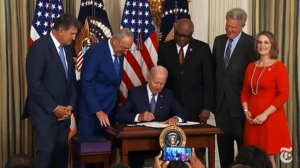President Biden Signs Historic Climate Bill into Law – part 2
 With President Biden’s signature, the $437 billion “Inflation Reduction Act,” became law today. The bill focuses on healthcare reforms, energy and climate initiatives, and represents a smaller version of the president’s “Build Back Better” plan, a centerpiece of his legislative agenda since taking office.
With President Biden’s signature, the $437 billion “Inflation Reduction Act,” became law today. The bill focuses on healthcare reforms, energy and climate initiatives, and represents a smaller version of the president’s “Build Back Better” plan, a centerpiece of his legislative agenda since taking office.
The Inflation Reduction Act further complements hte Presdient’s pervious bi-partisan success having already managed a massive pandemic rescue package focused on infrastructure and rebuilding America’s crumbling roads and bridges, along with needed incentive programs to turbocharge domestic computer chip production. Biden’s new bill is arguably an even bigger deal, with it’s the most significant achievement addressing global heating through US climate legislation by targeting the reduction of four billion tons of GHG emissions with tax breaks for electric vehicles, and zero emissions solar and wind energy development.
The sweeping legislation is also expected to reduce the deficit by a tax baseline paid targeting corporations which previously paid zero income taxes through legal loopholes in the code – taxes which were slashed by Republicans during the Trump administration. Equally ground breaking, the bill finally allows Medicare to negotiate lower drug prices, a common government practice in Canada and most EU countries.
“This is a historic moment,” Biden proclaimed at the signing ceremony. “Democrats sided with the American people and every single Republican in Congress sided with the special interests.”
The final bill language includes clean electricity incentives that are comparable in size to those in the previous House version, but scales back spending in almost every other category, from transportation to climate resilience. The one major exception was manufacturing: Compared with previous versions of the bill, the final legislation marks a significant increase in grants, loans and tax credits to manufacture clean energy technology domestically.
Democrats have said the new bill’s deficit reduction, as well as the provisions aimed at lowering energy and prescription drug costs, will help address the rapid inflation over the past year. Most economists agree with this assessment, the bill will likely reduce price pressures, however, the overall effect is likely to be modest in the long term.
What’s in the Inflation Reduction Act
Figures are in billions and over 10 years.
HEALTH CARE | COST IN BILLIONS |
|---|---|
| Affordable Care Act subsidies Expanded subsidies for three years | $64.1 |
| Medicare prescription drug benefit Increased generosity through Part D redesign and a $35 cap on co-payments for insulin | $34.2 |
CLEAN ENERGY – ELECTRICITY | COST IN BILLIONS |
|---|---|
| New tax credits for emissions-free electricity sources and storage Including wind, solar, geothermal, advanced nuclear, etc. | $62.7 |
| Extending existing tax credits for wind and solar power | $51.1 |
| Tax credit for existing nuclear reactors To prevent them from closing | $30.0 |
| Extend energy credit Through 2024 | $14.0 |
| Clean energy rebates and grants for residential buildings Rebates for installing heat pumps and retrofitting homes | $9.0 |
| Financing for energy infrastructure Updates and expands lending programs to make energy generation and transmission more efficient | $6.8 |
| Tax credit for carbon capture and storage | $3.2 |
MANUFACTURING MODERNIZATION | COST IN BILLIONS |
|---|---|
| Clean manufacturing incentives Incentives for companies to manufacture clean energy technologies in the U.S. rather than abroad, through tax credits and the Defense Production Act | $37.4 |
| Reduce emissions from energy-intensive industries Such as concrete production | $5.3 |
INDIVIDUAL CLEAN ENERGY INCENTIVES | COST IN BILLIONS |
|---|---|
| Green energy credits for individuals Extends and increases tax credits for energy-efficient properties | $36.9 |
ELECTRIC VEHICLES AND CLEAN FUELS | COST IN BILLIONS |
|---|---|
| Tax credits for new and used electric cars Incentives for purchasing emissions-free vehicles, with income limits, and for installing alternative fueling equipment. | $14.2 |
| Clean hydrogen production | $13.2 |
| Fuel tax credits Creates new credits for low-carbon car and airplane fuels, and extends credits for biodiesel and other renewable fuels | $8.6 |
| Financing for clean energy vehicles Loans and grants for the production of hybrid, electric and hydrogen fuel cell cars | $2.9 |
AIR POLLUTION ABATEMENT | COST IN BILLIONS |
|---|---|
| “Green bank” for energy investments For investments in clean energy projects, particularly in poor communities | $20.0 |
| Other air pollution reduction Includes funding for monitoring and reducing pollution, and grants for disadvantaged neighborhoods | $14.8 |
CONSERVATION, RURAL DEVELOPMENT AND FORESTRY | COST IN BILLIONS |
|---|---|
| Agricultural conservation Funding for agricultural practices that improve soil carbon, reduce nitrogen losses and decrease emissions | $16.7 |
| Rural development Investments in clean energy technology in rural areas | $13.2 |
| Forest conservation and restoration Includes funding to reduce risk of wildfires | $4.8 |
TRANSPORTATION AND INFRASTRUCTURE | COST IN BILLIONS |
|---|---|
| Improvements to federal buildings and highways | $5.2 |
| Electric transmission Loans and grants to finance electricity transmission, including for offshore wind energy generation | $2.3 |
CLIMATE-SPECIFIC SPENDING | COST IN BILLIONS |
|---|---|
| Drought resilience | $4.6 |
| Weather and climate resilience Includes investments in coastal areas and weather forecasting resources | $4.6 |
| Other federal research, projects and oversight Includes funding for FEMA, D.H.S. and D.O.E. | $4.2 |
| Zero-emissions U.S.P.S. trucks | $3.0 |
| National Park Service funding Includes funds for climate resilience and habitat preservation | $1.0 |
| Data collection and environmental reviews | $0.8 |
| Other | $0.7 |
| Tribal funding Clean energy, electrification, drought relief and climate resilience for federally recognized tribes. | $0.5 |
| Wildlife recovery and habitat climate resilience | $0.3 |
Savings and new revenue: $764 billion
TAX CHANGES | REVENUE IN BILLIONS |
|---|---|
| 15% corporate minimum tax | $222.2 |
| I.R.S. enforcement Projected net revenue raised from $80 billion in compliance and enforcement funding. | $124.1 |
| Stock buyback tax | $73.7 |
| Extend active loss tax limitation two years | $52.8 |
HEALTH CARE | REVENUE IN BILLIONS |
|---|---|
| Repeal a regulation on prescription drug rebates This regulation has never gone into effect, so the savings are mostly just on paper | $122.2 |
| Drug price negotiation* Medicare negotiation on prices for certain drugs | $99.0 |
| Limits on drug price increases* | $62.3 |
*These are estimates and subject to minor changes to the drug price provisions in exact cost and savings estimates. Savings from the drug price negotiation policy may end up being lower, and the savings from limits on drug price increases are unofficial estimates based on an analysis by Don Schneider, a former chief economist of the House Ways and Means Committee.
ENERGY AND CLIMATE-CHANGE ABATEMENT | REVENUE IN BILLIONS |
|---|---|
| Methane reduction incentives Sets methane waste emissions thresholds and charges facilities that exceed them. (Increased revenue net of new spending.) | $4.8 |
| Reinstatement of Superfund Increased revenue net of new spending. | $1.2 |
| Tax to fund the Black Lung Disability Trust Fund Permanent extension | $1.2 |
| New oil and gas leases On federal land and in the Gulf of Mexico | $0.5 |
| Other tax adjustments | $0.3 |
| Wind lease sales | $0.2 |




Leave a Reply
Join the Community discussion now - your email address will not be published, remains secure and confidential. Mahalo.